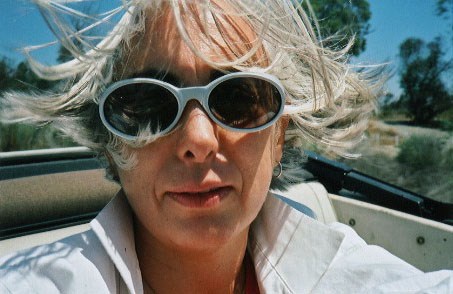 |
| Connie Samaras (Jennifer Terry) |
Connie Samaras is an artist, photographer, and professor at the University of California, Irvine. But this doesn't cover all of what she has been and done. Her artistic path has crossed with scientific exploration in the harshest realms: outer space and the South Pole. Through her work, she has learned much about who is a hero - and she is one herself.
Connie was born in a small town in New Mexico, in the early 1950's. She grew up speaking several languages, including Greek, English, and basic Spanish and Navajo. In those days, New Mexico was a much wilder and more rural place than it is today, and, as Connie grew up in the public schools, there wasn't much art or culture. Her mother encouraged her to play piano, and she studied art out of the few books there were. Connie was the first member of her family to go to college, and it was there that her view of the larger world expanded. Finally, she could meet people who had interests in art and literature - who were passionate about ideas - and this set the course for the rest of her life.
Connie's first hero was Superman, but she always wondered why there was no "Superwoman." There was Supergirl, but she really wasn't Superman's equal at all. In the 1950's and 1960's, roles for women were limited. For example, with very few exceptions, women couldn't enter the sciences, there was no provision for women's sports in college, and women didn't earn as much as men for the same jobs. Connie knew that things weren't equal between men and women, and, in college, she got together with other people who felt the same way.
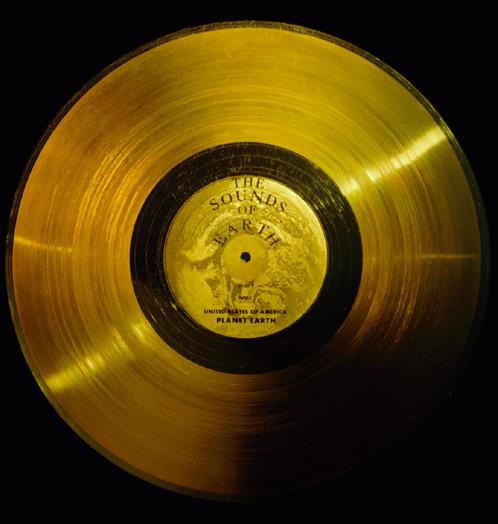 |
| Golden Voyager Disc (NASA) |
Some of Connie's art projects have tried to do something about this inequality. In 1977, NASA launched the spacecraft Voyager 1 and Voyager 2 into the outer reaches of our solar system, eventually to speed into interstellar space. Each spacecraft bore a golden copper disc, with instructions for use, containing the sights and sounds of Earth, which an alien from a distant world could play, see, and hear. Connie was concerned that the music, voices, and images that the scientists had chosen did not show all the cultures of the world, and did not represent women fairly. She went to NASA's Jet Propulsion Laboratory in Pasadena, California and examined the contents of the disc. She then designed the contents of a new disc, selecting pictures, sounds, and information in a way that really did show everything that the Earth and its peoples had to offer. NASA hasn't scheduled a new deep space mission yet, but when it does, Connie's new disc will be ready.
Connie, though, is an artist as much as an activist. To her, photography is very important, because it is what most people see around them. She doesn't take thousands and thousands of pictures, though. "When you speak," she says, "you don't say everything that comes into your head about everything you see." She likes to think about her photographs. She isn't always interested in creating beautiful pictures of nature, like Ansel Adams or some other famous photographers. Sometimes she wants people who see her photographs to think about parts of popular culture which are taken for granted or thought absurd. For example, the Voyager project makes people's obsession with "space aliens" and "alien abductions" seem rational; what would you really say to aliens when you met them? At other times, she wants to make the familiar seem less familiar. Her photographs show real places, but the way in which she organizes the photographs' colors and lighting makes the places seem unreal. They may look like they have come out of a computer, but Connie has used a real camera and real places. She's just used her photography skills to make the prints come out this way.
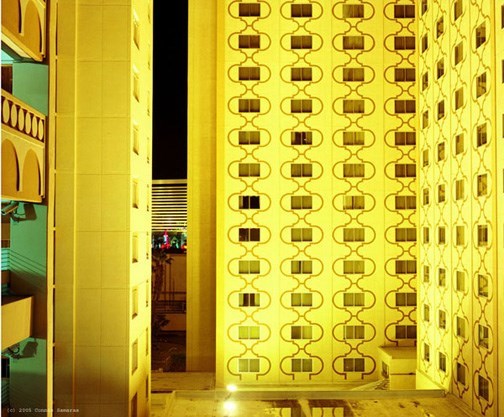 |
| Sahara Hotel, Las Vegas, alert level orange |
The bravest art project Connie has ever done was also a science project: Connie has taken photographs at the South Pole.
The South Pole, the "bottom of the world," is on the icy continent of Antarctica. It is the most hostile environment for life outside of outer space. Temperatures can go as low as seventy degrees F below zero - in summer. Winds can come rushing in at seventy miles an hour. Without proper clothing and shelter, you would die in minutes.
Antarctica is alone among the continents of the world in that no part of it is governed by any country. A treaty set up by the United Nations makes sure that everybody who goes there respects the environment and will not harm anyone else. Sixteen countries have scientific research stations on the ice. Many of the scientists there are astronomers, because it is at the South Pole that one can get the clearest view of the stars. Other scientists are geologists, who are taking samples of ice as far down as they can get, in order to see what Earth was like in the past.
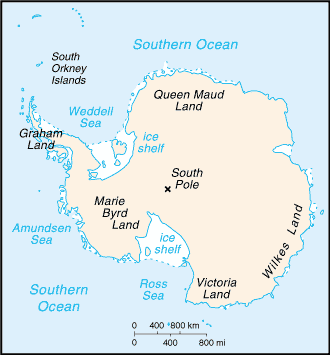 |
| Map of Antarctica (CIA) |
Connie was chosen to go to the South Pole through a program set up by the National Science Foundation called the Antarctic Artists and Writers Program. She wanted to go there to take pictures of buildings being eaten by the ice; given enough time, the ice at the South Pole eats everything. Every fifty years, the old buildings sink into the ice and new buildings have to be built. Connie saw buildings from the 1950's deep in the ice, and a big dome from the 1970's halfway submerged.
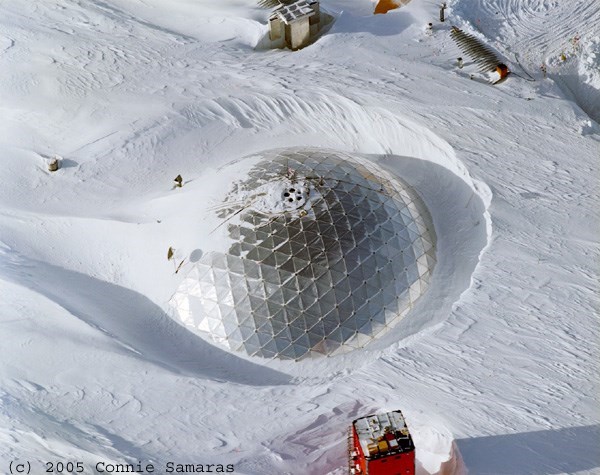 |
| Sunken 1970's dome. |
Right now, the Americans at the South Pole are constructing a new building designed in the 1990's.
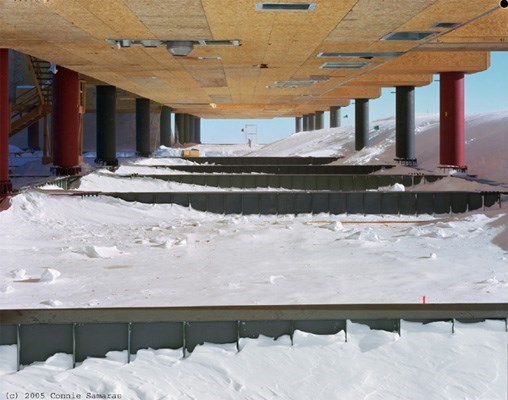 |
| Under new station |
She had to endure a very tough physical examination in order to win her place at the Pole. It is harder than any other test except the one to be an astronaut. Even once she passed the test, she was unprepared for how hard it was going to be. In order to work her cameras, she had to take her gloves off, and the wind made huge bleeding cracks in her hands. Every morning, she would go to the nurse at the American polar base, the nurse would fill in the cracks with SuperGlue(tm), and Connie would go out for another day's work.
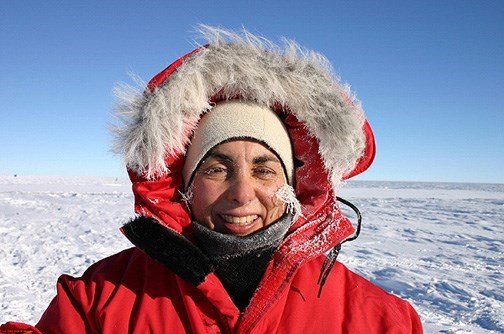 |
| Connie at South Pole |
Connie knew that she would like the South Pole. It is completely isolated from the outside world, except for a few minutes each day when a satellite passes overhead. There's almost no phone and no email. Supply ships and planes come at the beginning and end of summer, but for the ferocious winter, the stations are on their own. You would think that with only a few people at the station, they would go nuts. But Connie found that everyone was nice to one another, and that people went out of their way to help others. When it is so difficult to survive, everyone depends on everyone else. That is a lesson which Connie feels we could use in our own countries: because everyone faces common problems, everyone should help everyone else.
Connie Samaras brought home more than pictures from the South Pole. She's come to understand something about heroes. We all have the ability to be heroic. We can look up to people we find inspirational, but it's the people with whom we have daily contact, like the people at the Pole, who have the capacity to be heroes.
Page created on 9/15/2005 12:00:00 AM
Last edited 1/9/2017 9:40:11 PM
